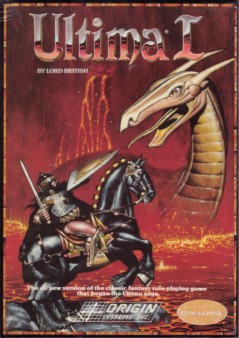Ultima I
| Ultima I: The First Age of Darkness | |
|---|---|

Box art from the 1986 edition.
|
|
| Developer(s) | Richard Garriott, Origin Systems |
| Publisher(s) |
Apple II California Pacific Computer Co. Origin Systems Atari 8-bit Sierra On-line Commodore 64 Origin Systems DOS Origin Systems Electronic Arts MSX2 Pony Canyon FM Towns Fujitsu Apple IIGS Vitesse Inc. |
| Designer(s) | Richard Garriott, Ken W. Arnold |
| Series | Ultima |
| Platform(s) | Apple II, Atari 8-bit, Commodore 64, DOS, FM Towns, MSX2, NEC PC-8801, NEC PC-9801, Sharp X1, Apple IIGS |
| Release date(s) |
Apple II Atari 8-bit Commodore 64 DOS
FM Towns Apple IIGS |
| Genre(s) | Role-playing video game |
| Mode(s) | Single-player |
Ultima, later known as Ultima I: The First Age of Darkness or simply Ultima I, is the first game in the Ultima series of role-playing video games created by Richard Garriott. It was first published in the United States by California Pacific Computer Company, which registered a copyright for the game on September 2, 1980 and officially released it in June 1981. Since its release, the game has been completely re-coded and ported to many different platforms. The 1986 re-code of Ultima is the most commonly known and available version of the game.
Ultima revolves around a quest to find and destroy the Gem of Immortality, which is being used by the evil wizard Mondain to enslave the lands of Sosaria. With the gem in his possession, he cannot be killed, and his minions roam and terrorize the countryside. The player takes on the role of 'The Stranger', an individual summoned from another world to end the rule of Mondain. The game follows the endeavors of the stranger in this task, which involves progressing through many aspects of game play, including dungeon crawling and space travel.
The game was one of the first definitive commercial computer RPGs, and is considered an important and influential turning point for the development of the genre throughout years to come. In addition to its influences on the RPG genre, it is also the first open-world computer game.
The world of Ultima is presented in a variety of different ways. The overworld is projected in a topdown, third person view, while dungeons are displayed in first person, one-point perspective. In both scenarios the player character is controlled with the keyboard directional arrows, and shortcut keys are used for other commands, such as A for attack and B for board.
...
Wikipedia
